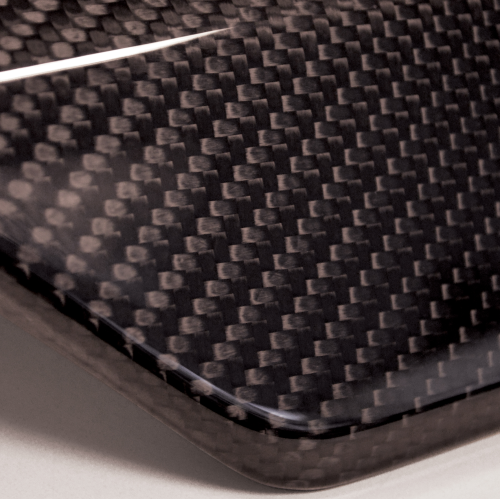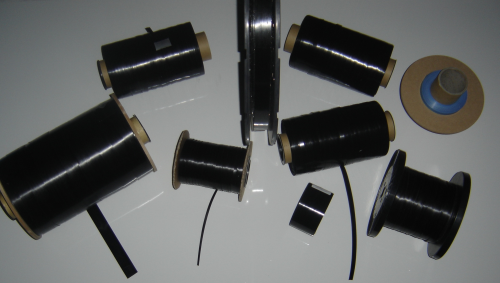

Part 2 of Reinforced Plastics' report on some recent developments in composites for automotives.
Gurit
Gurit has developed new prepreg materials that are widely used in automotive applications and in some other demanding and high-temperature applications. Gurit says that this new range of prepregs provides manufacturers with composite materials designed for a variety of applications, both structural and cosmetic. SC 110 cosmetic carbon prepreg offers ultra high clarity, making it ideal for cosmetic components with no whitewash or spots. SC 110 cosmetic carbon prepreg utilises a high clarity, versatile, hot-melt epoxy resin formulation. Gurit says that the formulation ensures that no white-wash or white spots are evident in the cured resin. It is ideal for manufacturing high visual quality components using autoclave and press processing. On average a 20% increase of yield of finished parts can be achieved due to the elimination of whitewash. It can be cured at temperatures as low as 80°C, or it can be used for faster moulding of components at 120°C. This is achieved with a good out-life of up to three weeks at 21°C. It is a toughened system, and offers good mechanical properties on a wide variety of reinforcing fabrics and fibres. This new carbon fibre prepreg can be used to produce components such as bonnets or grills but also more complex shapes with tight curvature. SE 200 structural carbon epoxy prepreg is a high strength structural carbon prepreg based on a toughened epoxy system. It has a flexible cure envelope range of 135-200°C. SE 200 has been developed to enable rapid part manufacture through a number of composite processing methods. The minimum cure temperature is 135°C from which SE 200 develops Tg and strength properties at a level associated with high temperature 195°C curing systems. Higher temperature cures in excess of 180°C will achieve the best dry and wet thermal performance, adds the company. Using the appropriate press moulding technology it is possible to achieve a 15 minutes hot-in/hot-out cure at 195°C, making SE 200 suitable for the economic production of automotive parts. According to Gurit, SE 200 structural carbon epoxy prepreg can be used in the making of parts such as structural lower tubs, bulkheads, front and rear scuttles, exhaust tunnels and other structural components. SE 300 high Tg prepreg is claimed to be an ideal material for high temperature composite applications, as it combines the ease of processing and handling convenience of epoxy resins, high temperature stability of polyimides, and flame/fire resistance of phenolics. A 120°C cure for 75 minutes combined with a post-cure, enables SE 300 to generate a Tg in excess of 300°C, making SE 300 ideal for applications in composite structures, which are exposed to very high temperatures for short durations.
Reichhold
Reichhold has introduced ADVALITE™ vinyl hybrid hot melt prepreg resins, which are monomer-free and testing confirms VOC-free in the cured state. According to the company, ADVALITE™ vinyl hybrid hot melt prepreg resins exhibit good mechanical properties and temperature resistance up to 170°C. These resins are cured using standard free radical inhibitors and initiators. Reichhold says that this allows significant processing advantages when compared to epoxy resins. Prepreg composites produced using ADVALITE™ can be stored at room temperature for 12 months and can be snap cured at 120-150°C. The first commercial application of ADVALITE™ was in prepreg supplied by Cytec Industries for application in the electric vehicle-battery enclosure on the 2014 General Motors Co. Chevrolet Spark EV. The ADVALITE™ resin served as the base resin for Cytec’s high volume MTM23 prepreg that is used on the Spark. The MTM23 had been adapted and mechanically characterised for high volume press mould processing, with good mechanical performance, controlled flow, excellent handling and self-release capability. Cytec and Reichhold say that they worked collaboratively through the prototype and production implementation phases of the Spark battery tray and continue to develop further enhancements to the vinyl hybrid technology. Prepregs produced using the ADVALITE™ technology can either be adhesive filmed or directed coated to the reinforcements. The free radical cure mechanism allows for extended room temperature storage while delivering snap cures at elevated temperatures. Reichhold says that when compared to epoxy resins ADVALITE™’s rapid rate of cure permits significantly reduced production cycle times. Additionally, in automotive headspace testing the cured laminate was demonstrated to be VOC-free.
Zoltek
Automotive developments from Zoltek include a carbon fibre roof panel with a premium and paintable surface manufactured via a new process called Surface RTM. This process is the result of a year-long industry partnership using the latest KraussMaffei RTM technology, Henkel PU chemistry, Chomarat C-Ply fabrics, Ruhl PU coatings, and Zoltek’s specially-sized Panex® 35 50K carbon fibre. The partnership resulted in a carbon fibre roof panel for the Roding Roadster that is ready to paint directly out of the mould and suitable for structural and semi-structural parts. Surface RTM eliminates the primer and sand process to hide print-through, which has the potential to significantly reduce final part costs. Zoltek Automotive has also worked on carbon SMC moulded parts in collaboration with Magna Exteriors using Zoltek’s Panex® 35 carbon fibre. Zoltek and Magna have worked to develop a low-cost carbon SMC product, which is now sold under Magna’s EpicBlend SMC™ product line. Designed to mould and flow in a traditional SMC compression process, this carbon SMC product provides automotive parts with lightweight, high mechanical properties, and high heat resistance. Additionally, Zoltek Automotive has made significant progress developing a prepreg material suitable for class-A automotive body panels. The fast-cure automotive-grade prepreg is capable of producing premium and paintable ‘class-A’ automotive body panels.
FRT Tapes
FRT Tapes has developed a high pressure impregnation system, which the company believes will be particularly important to the automotive industry. The system is claimed to allow a very high fibre content in produced sheets and tapes. According to FRT Tapes, various tests have shown that its product has twice the strength of regular steel and 75% of the strength of high strength steels. In addition, its rigidity and strength is three times that of the commonly-used long fibre thermoplastics. In the production of high volumes, glass-filled polypropylene and glass-filled polyamide are used. FRT Tapes adds that in order to meet future European emission targets, the company set out to develop a product that was made from sustainable materials, inexpensive, light, easy-to-recycle and suited for mass production.
Momentive Specialty Chemicals
Momentive Specialty Chemicals has further developed its two-minute cure technology for the mass production of composite automotive components. The company has partnered with the Technical Center for the Mechanical Industry (CETIM) in France. The collaboration has produced a new automotive crash-box concept that reduces vehicle weight, provides the same or better energy absorption, and can be mass produced at a competitive price. The organisations have taken Momentive’s two-minute cure technology featuring EPIKOTE™ 05475/EPIKURE™ 05500 curing agent, and Heloxy additive 112, and developed a cost competitive composite crash-box concept that can meet a 1,000 parts per day production rate.
Read Part 1
This article was published in the May/June 2014 issue of Reinforced Plastics magazine.
The digital edition of Reinforced Plastics is distributed free of charge to readers who meet our qualifying criteria. You can apply to receive your free copy by completing this short registration form.





